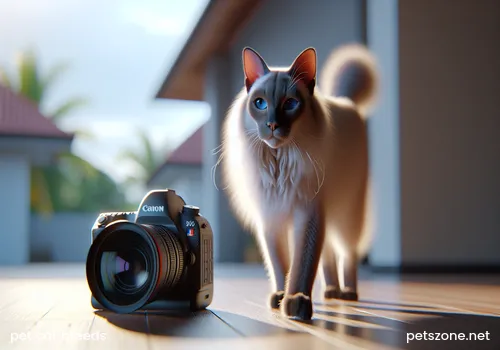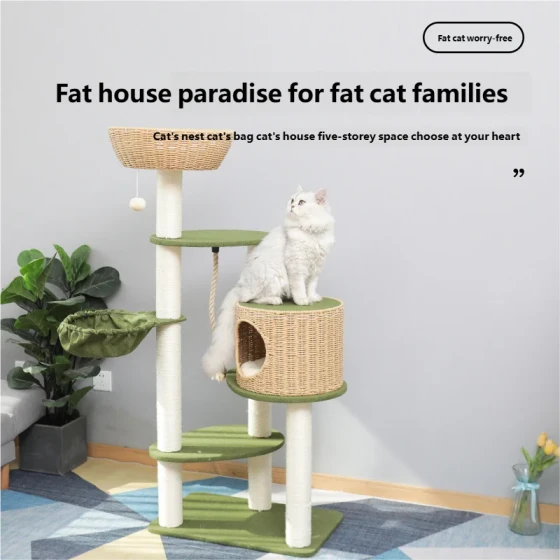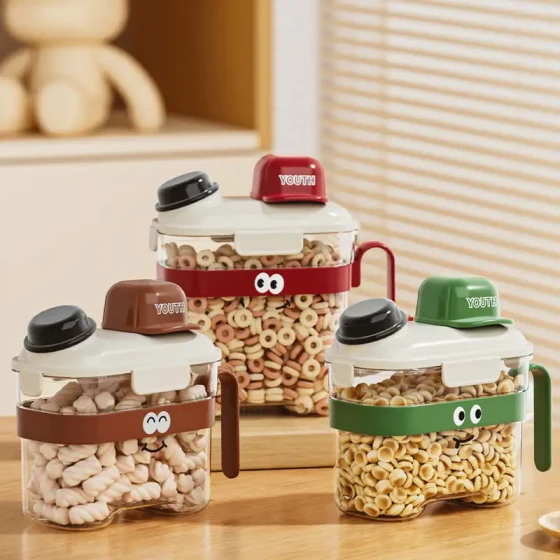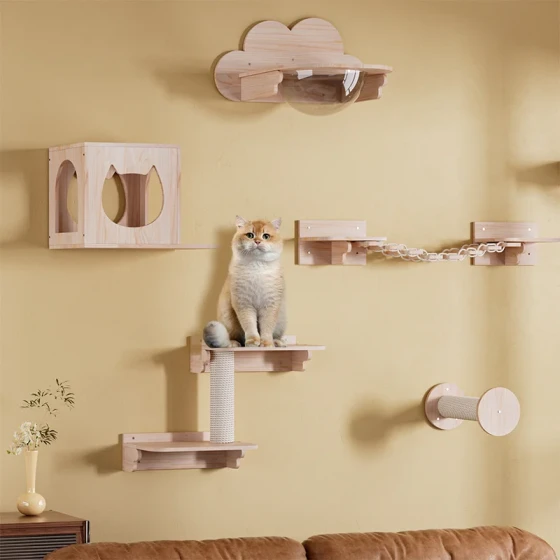What Are the Breeds of Pet Cats_Common Cat Types and Full Analysis of Characteristics
Cats, as close companions to humans, have won the love of countless “pet owners” worldwide with their elegant posture, variable personalities, and unique appearances. They are not only a landscape in the home but also an indispensable emotional support in our lives. From lively and active short-haired cats to gentle and elegant long-haired cats, there are many cat breeds, each with its own charm.
This article will detail several common pet cat breeds and their unique features to help you better understand these "meow beings" and prepare for future cat-keeping life.
Exploring the World of Cats: Full Analysis of Common Cat Types and Their Characteristics

Cat breeds are diverse, and every “cat master” has its unique “cat setting.” Choosing a cat that fits your family and lifestyle is crucial. Here are several top trending cat breeds in the pet world presented for you:
1. British Shorthair: The Steady and Sturdy “Blue Chubby”
The British Shorthair, abbreviated as “Brit Shorthair,” is beloved for its round face, short and stout limbs, and chubby body, especially the classic blue-gray color, often playfully called the “Blue Chubby.”
* Appearance Features: Brit Shorthairs have dense, plush short fur with a variety of coat colors, including classic blue, black, white, red, cream, and more. They have a round head, large round eyes, strong chin, and short thick neck.
* Personality Traits: Brit Shorthairs are gentle, friendly, steady, and quite independent. They are usually quiet, not noisy, friendly to people, and enjoy their owner’s affection. For busy office workers, Brit Shorthairs are a good choice as they can entertain themselves well.
* Care Tips: Although a short-haired breed, their dense fur requires regular grooming to maintain cleanliness and reduce shedding. They dislike exercise and tend to gain weight easily, so diet control and encouraging moderate exercise are necessary.
2. Ragdoll: The Ethereal “Little Fairy”
The Ragdoll, also called the “Bradoll cat,” is famous for its gentle, friendly, and extremely affectionate personality and is known as the “Fairy Cat” or “Little Dog Cat.” They relax their bodies when held, like soft dolls, hence the name.
* Appearance Features: Ragdolls are a relatively large and heavy cat breed. They have soft, long fur and big blue eyes as their signature features. The colors vary widely, commonly seal, chocolate, blue, lilac, with patterns including bicolor, mittens, and colorpoint.
* Personality Traits: Ragdolls are docile, intelligent, sociable, very friendly to people, rarely shy, even friendly to strangers. They like to be close, are clingy, and have high pain tolerance, suitable for families with children. They also have some independence and can adapt to being alone when their owner is out.
* Care Tips: Ragdolls’ long fur needs frequent brushing and cleaning to prevent mats. Due to their large size, they require high-quality nutrition to support growth.
3. Maine Coon: The “Giant” of the Cat World
The Maine Coon is the first long-haired cat breed naturally developed in North America, famous for its large size and gentle temperament, dubbed the “little giant” of cats.
* Appearance Features: Maine Coons are robust with sturdy bones and muscular bodies and are among the largest domestic cat breeds. They usually have long, fluffy fur, especially a “mane” around the neck similar to a lion’s mane. Their heads are square, ears large and erect with tufted tips, eyes oval-shaped. Fur colors and patterns are very diverse, over 60 types.
* Personality Traits: Despite their rough looks, Maine Coons are very gentle, friendly, and loyal. They are smart, independent, understanding, enjoy interaction and play, can learn tricks, and are called “dog-like cats.” They get along well with children and other pets.
* Care Tips: Maine Coons have thick fur needing regular grooming to reduce shedding. Due to their size, they need ample activity space and high-quality diet during youth to support bone and muscle growth. Note that Maine Coons are prone to hereditary problems like hip dysplasia, so choosing reputable breeders is important.
4. Siamese: The Walking "Chatterbox" and "Coal Miner"
The Siamese, originating from Thailand (formerly Siam), is a famous short-haired breed known for its unique appearance and lively personality.
* Appearance Features: Siamese cats have a slim, muscular body, wedge-shaped head, large upright ears, almond-shaped eyes usually deep blue. Their most distinct feature is the “pointed” coat, with darker colors on the face, ears, legs, and tail ends. The color darkens with temperature changes, leading to the nickname “coal miner.” Newborn Siamese are usually all white; the pointed colors emerge as they grow and as the environment cools.
* Personality Traits: Siamese cats are lively, smart, agile, loyal, and clingy. They communicate emotions and needs clearly, are loud “talkers,” and like to “converse” with their owners. They require social interaction and mental stimulation.
* Care Tips: Siamese cats have high energy and need plenty of playtime and companionship, or they may act destructively. Their coat color depends on temperature, so owners should maintain appropriate room temperature (around 25-30°C).
5. Persian: The Elegant “Noble”
Persians are among the oldest cat breeds, famous for their luxurious, fluffy long fur and sweet, gentle personality. They are considered the “king of cats” by many. The cartoon “Garfield” is based on a Persian cat.
* Appearance Features: Persians have very long and fluffy coat, round and wide head, full cheeks, short nose (some have “flat face” traits), and large round eyes. Their colors are numerous, including solid, multicolor, and patched. Chinchilla cats are a Persian branch with less flat faces but similarly long fur and dark eye lines.
* Personality Traits: Persians are gentle, quiet, and stable, dislike noise, and prefer a peaceful environment. They are affectionate and highly dependent on their owner’s care. Though they dislike intense physical activity, they sometimes show kitten-like vitality.
* Care Tips: Persians have thick undercoats requiring frequent grooming to prevent mats and reduce shedding. Some Persians' flat faces can cause respiratory and other health issues, so picking healthy cats and regular check-ups are very important.
6. Canadian Hairless Cat: The Independent “Warm Baby”
The Canadian Hairless Cat, also known as the “Sphynx cat,” is popular among some cat lovers for its unique hairless appearance and affectionate personality.
* Appearance Features: Hairless cats are not entirely hairless; their bodies are covered with fine downy fur, feeling like warm peach skin or suede. They usually have large round eyes, wide upright ears, and wrinkled skin, especially in kittens, which have more wrinkles.
* Personality Traits: Hairless cats are gentle, smart, humble, sensitive, very close to people, and highly dependent. They love being held and petted and often follow their owners. They are lively, curious, and unafraid of strangers, friendly with family members and other pets.
* Care Tips: Without thick fur protection, hairless cats have poor temperature regulation, fearing cold and heat. Indoor temperature should be kept between 25-30°C. Sunscreen is needed in summer, and clothes in winter. Their skin tends to be oily and requires frequent baths. Their body temperature is about 4°C higher than average cats, with a fast metabolism, so they need to eat often to maintain energy.
7. Chinese Rural Cat: The Ever-Changing “Big Orange Matters Most”
The Chinese Rural Cat, commonly known as “local cat,” lacks the strict breed selection and classification of purebreds, but it has a long history and wide popularity in China, being the loyal partner in many families.
* Appearance Features: The Chinese Rural Cat’s appearance varies greatly, with no uniform standard, from common tabby cats, “big orange matters” orange cats, to calicos (white, black, orange patches), black cats, white cats, each with unique charm. They are usually medium-sized, sturdy-boned, with short, dense fur.
* Personality Traits: Chinese Rural Cats are usually independent, curious, and adaptable. Smart and lively, skilled hunters, able to adjust to various environments. Once trust is established, they become very clingy and loyal, even “spoiling” their owners.
* Care Tips: Chinese Rural Cats generally have good health and are less prone to illness, with relatively low maintenance costs. However, scientific feeding, regular deworming, and providing appropriate space and companionship remain important.
Think Carefully Before Raising a Cat: How to Choose the Right Cat for You?
Choosing a cat is a big deal, like finding a compatible roommate, requiring careful thought. The following aspects can help you make a wise decision:
- Lifestyle: Are you a nine-to-five office worker or a freelancer working from home? If time is limited, independent cats like British Shorthair or American Shorthair might suit you better. If you want a clingy “little follower,” Ragdoll or Siamese cats are ideal choices.
- Living Environment: Is it a spacious detached house or a cozy apartment? Large cats like Maine Coons may require bigger activity spaces, while quieter cats like Persians and British Shorthairs adapt well to apartment life.
- Care Commitment: Do you have time to groom long-haired cats daily? Can you accept skin care for hairless cats? If you want a low-maintenance pet, short-haired cats might be more suitable.
- Family Members: Are there children or elderly at home? Gentle and tolerant breeds like Ragdolls and Maine Coons usually get along well with kids.
- Allergy Issues: If you or family members are allergic to cat hair, hairless cats may be a good choice as they shed less and usually don’t cause allergic reactions.
Common Questions and Answers
- Which cat breeds are best for beginners?
British Shorthair, American Shorthair, and Chinese Rural Cats are generally considered beginner-friendly breeds. They have gentle personalities, strong adaptability, and relatively easy care. Ragdolls are also a good option; although they require more grooming, their extreme affection compensates for it. - What is the average lifespan of a cat?
Cat lifespan varies by breed, care, and health. Generally, domestic cats live about 12-15 years, some even over 20. For example, Ragdolls can live 15-25 years. - How much does it roughly cost to keep a cat?
Costs vary by city, breed, and personal consumption habits. Purchase prices range from a few hundred to several thousand yuan, with Chinese Rural Cats often available for free via adoption. Monthly expenses mainly include food, litter, vaccines, deworming, toys, and scratching posts, around 200-500 yuan RMB. Medical and grooming costs will add more. - What are common cat diseases and how to prevent them?
Common cat diseases include feline distemper (panleukopenia), feline infectious peritonitis (FIP), feline AIDS, chronic kidney disease, diabetes, dental diseases, ear mites, etc. Prevention includes regular vaccinations, deworming, balanced diet, sufficient water, clean environment, regular health checks, and avoiding contact with unknown cats.
Conclusion
No matter the breed, cats bring endless joy and warmth to our lives. Each cat is a unique life, needing the owner’s love, patience, and responsibility. Before deciding to bring a cat home, please fully understand their characteristics and needs, and prepare for long-term companionship. May every pet owner begin a happy journey with their “furry child”!



